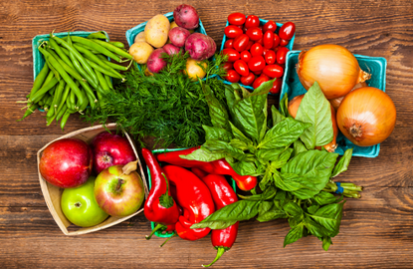Breaking Down the Fundamentals of Eating
Whether you’re working on losing weight or just want to improve your diet, these fundamentals of healthy eating will help you make sound choices. With all the diet trends, eating fads, and weight loss claims, it can be confusing to figure out what to eat and how often. There’s no need to follow a restrictive diet or extreme eating program that leaves you feeling hangry. Food is meant to be enjoyed, and you can appreciate it with a balanced eating plan. This guide will help you make healthy eating choices with science-backed strategies.
Healthy eating involves a varied diet with plenty of nutrients. This means consuming a colorful array of foods that includes plenty of fruits and vegetables, whole grains, and lean proteins. One of the challenges of healthy eating is getting enough nutrients without too many calories. Choosing whole, real foods that are high in nutrients will help you get what your body needs while feeling fuller. On the other hand, some foods are high in calories and low in nutrients - such as processed snack foods, fried foods, baked goods, chips, juice, and soda - and you can gradually reduce the amount of these foods in your diet as part of your healthy eating plan. Ultimately, you can still enjoy even your favorite snacks or desserts in moderation as long as you eat enough nutritious foods regularly.
8 Tips for Healthy Eating
1. Eat lots of fruits and veggies. Produce is high in nutrients, including vitamins, minerals, and fiber, and this will help your body stay full and operate smoothly. Go for a rainbow of colors, eating fruits and vegetables of different varieties and you’ll pack in the healthy nutrients. Some ways to get more fruits in your diet include adding fresh fruit as toppings with snacks such as yogurt and also grabbing fresh fruit for a healthy dessert. Similarly, you can amp up your vegetable intake by adding veggies to your meals as a side dish or incorporating them into your regular foods by adding them to your salads, sandwiches, and grain-based dishes such as rice or quinoa bowls.
2. Choose whole grains. Reach for whole grains instead of refined, processed grains, and your body will thank you. Whole grains such as oatmeal, whole wheat bread, quinoa, brown rice, barley, popcorn, and wild rice help lower your chance of getting chronic diseases like heart disease, high blood pressure, and diabetes. Refined grains such as white bread, white rice, and white flour foods, on the other hand, are linked with obesity and inflammation, so limit your intake of refined grains.
3. Eat at home more. Eating out is often packed with low-nutrient foods and high calories, which is a recipe for weight gain and feeling hungry. Opt to eat at home more or prepare your food at home and bring it to work so you can have nutritious meals on the go. If you do eat out, don’t be afraid to ask about nutrition information. Some ways to make healthy choices when dining out include splitting a main dish to keep your portion size smaller and going for vegetable-based dishes or those with lean, baked, or grilled protein such as grilled salmon or chicken.
4. Cut down on processed foods. Processed foods are foods that are changed from their original form and nutrients such as vitamins and minerals are removed during the processing. Most processed foods are high in added salt and sugars and low in nutrients, making them empty calories. Limit your intake of processed foods like chips and cookies and keep healthy alternatives on hand instead. Some healthy snack options include nuts, fruits, Greek yogurt with fruit, homemade popcorn, hard-boiled eggs, fresh hummus, avocado, guacamole, and edamame.
5. Limit sugar intake. Going along with reducing your processed food intake, also limit your sugar intake. Watch food labels for the sugar content and avoid foods with a high amount of added sugar. A lot of cereals, fruit juices, syrups, and sauces are high in sugar, so check labels before buying. How much sugar is too much? According to the Dietary Guidelines for Americans, people should limit sugars to less than 10% of their total daily calories. So if you eat 2,000 calories a day, for instance, no more than 200 of your calories should come from sugar.
6. Drink more water. Instead of drinking high-sugar drinks like juices, soda, or alcohol, reach for water. Making water your drink of choice will help you stay hydrated without consuming empty calories. Water helps the digestion process and aids with weight loss and maintenance. Avoid drinking juices as the juicing process results in a high density of sugar and it’s much healthier and more nutrient-dense to eat whole fruits (fresh or frozen). Similarly, soft drinks and alcohol are also high in sugar content and offer no nutritional value.
7. Cut down on saturated fats and trans fats. Saturated and trans fats are unhealthy and can raise your bad cholesterol and put you at a higher risk of getting heart disease. Saturated fats are often found in animal-based foods such as red meat, cheese, lard, ice cream, and butter, as well as tropical oils and some baked and fried foods. Trans fats are found in many fried foods, fast foods, stick margarine, and baked goods such as cakes, pie crusts, biscuits, frozen pizzas, cookies, and crackers. Look for ingredients that say partially hydrogenated oils as this means there are trans fats in the food. The American Heart Association recommends minimizing your trans fats intake and reducing saturated fats to 5 to 6% of your total calories.
8. Don’t starve yourself. At the end of the day, you do not want to restrict yourself to the point of feeling hungry or deprived. We all need plenty of food and nutrients to function properly, and it’s healthy to enjoy food. Just make sure you reach for nutrient-dense foods as much as possible, and indulging in a small sweet treat or favorite salty snack from time to time won’t hurt you.





